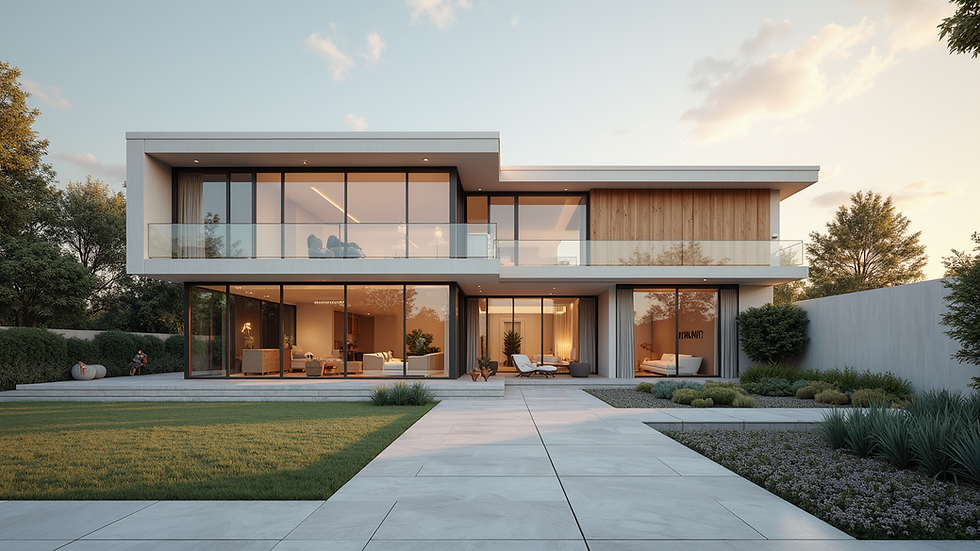The Role of Visualization in Modern Architecture
- louai86alsam
- 16 minutes ago
- 3 min read
In the evolving world of architecture, visualization has become a cornerstone of the design and construction process. It bridges the gap between imagination and reality, allowing architects, clients, and stakeholders to see a project before it is built. This powerful tool enhances communication, improves decision-making, and ultimately leads to better architectural outcomes.
How Architectural Visualization Transforms Design Communication
Architectural visualization is more than just pretty pictures. It is a dynamic way to communicate complex ideas clearly and effectively. Traditional blueprints and sketches can be difficult for non-experts to interpret. Visualization tools, however, provide realistic 3D models and immersive experiences that make designs accessible to everyone involved.
For example, a client can walk through a virtual model of their future home, exploring every room and detail. This interaction helps identify potential issues early, such as awkward layouts or lighting problems, which can be corrected before construction begins. It also fosters collaboration between architects, engineers, and contractors by providing a shared visual reference.
Key benefits include:
Enhanced understanding of spatial relationships
Improved client satisfaction through realistic previews
Faster approval processes due to clearer presentations
Reduced costly changes during construction

The Impact of Architectural Visualization on Project Efficiency
Using visualization tools significantly boosts project efficiency. By simulating materials, lighting, and environmental conditions, architects can experiment with different design options quickly and cost-effectively. This iterative process leads to more refined and optimized designs.
Moreover, visualization helps in marketing and sales. Real estate developers use photorealistic renderings to attract buyers and investors by showcasing the final product in its best light. This can accelerate funding and sales cycles, providing a competitive edge in the market.
Practical recommendations for leveraging visualization include:
Integrate visualization early in the design phase to guide decisions.
Use high-quality renderings for client presentations and marketing.
Employ virtual reality (VR) to offer immersive walkthroughs.
Collaborate with visualization specialists to maximize impact.

What is the AI Tool for Architectural Visualization?
Artificial intelligence (AI) is revolutionizing architectural visualization by automating and enhancing many aspects of the process. AI-powered tools can generate detailed 3D models from simple sketches or floor plans, saving time and reducing manual effort.
These tools also improve realism by simulating natural lighting, textures, and environmental effects with high accuracy. AI can analyze design data to suggest improvements or detect potential issues, making the design process smarter and more efficient.
Some AI applications include:
Automated 3D modeling from 2D drawings
Real-time rendering with adaptive lighting
Predictive analytics for structural and environmental performance
Generative design that proposes innovative architectural solutions
By incorporating AI, architects can focus more on creativity and less on technical constraints, pushing the boundaries of modern architecture.
Practical Applications of Architectural Visualization in Construction
Beyond design, visualization plays a critical role during construction. Detailed 3D models help contractors understand complex structures and coordinate workflows. This reduces errors, minimizes delays, and improves safety on site.
For instance, clash detection software uses visualization to identify conflicts between mechanical, electrical, and plumbing systems before installation. This proactive approach prevents costly rework and streamlines project timelines.
Additionally, visualization supports facility management after construction. Digital twins—virtual replicas of buildings—allow owners to monitor performance, plan maintenance, and optimize operations efficiently.
Actionable tips for construction teams:
Use 3D models for pre-construction planning and coordination.
Implement clash detection to avoid installation conflicts.
Employ digital twins for ongoing building management.
Train staff with virtual simulations of construction processes.
Future Trends in Architectural Visualization
The future of architectural visualization is exciting and full of potential. Emerging technologies like augmented reality (AR) and mixed reality (MR) will further enhance how designs are experienced and understood. Imagine clients using AR glasses to see a building superimposed on its real-world site or architects collaborating in a shared virtual space.
Sustainability is also becoming a focus. Visualization tools will increasingly incorporate environmental data to help design energy-efficient and eco-friendly buildings. This integration supports global efforts to reduce carbon footprints and promote green architecture.
To stay ahead, professionals should:
Explore AR and MR for interactive design presentations.
Integrate sustainability metrics into visualization workflows.
Keep up with AI advancements to automate routine tasks.
Foster interdisciplinary collaboration using shared digital platforms.
Architectural visualization is not just a trend but a fundamental shift in how architecture is conceived, communicated, and constructed. Embracing these tools and technologies will lead to more innovative, efficient, and sustainable buildings in the years to come.
For those interested in exploring this field further, architectural visualization offers a wealth of resources and examples to inspire your next project.




Comments